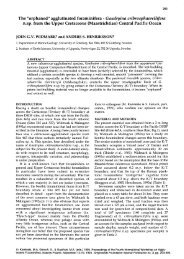Full Text | Download - Grzybowski Foundation - The ...
Full Text | Download - Grzybowski Foundation - The ...
Full Text | Download - Grzybowski Foundation - The ...
Create successful ePaper yourself
Turn your PDF publications into a flip-book with our unique Google optimized e-Paper software.
Alegret, Ortiz & Kaminski (eds.), 2012. Ninth International Workshop on Agglutinated Foraminifera, Abstract Volume<br />
Dominance of the invasive agglutinated foraminifera Trochammina hadai Uchio<br />
in San Francisco Bay, USA, less than two decades after its introduction<br />
Mary MCGANN<br />
U.S. Geological Survey, Pacific Coastal and Marine Science Center, 345 Middlefield Road, M/S 999,<br />
Menlo Park, CA, 94025, USA.<br />
e-mail: mmcgann@usgs.gov<br />
San Francisco Bay is the largest estuary on the west coast of the United States and consists of<br />
several subembayments, including informally named north bay (San Pablo, Suisun, Grizzly,<br />
and Honker Bays), central bay (with Richardson Bay), and south bay. A common agglutinated<br />
estuarine foraminifera in Japan, Trochammina hadai Uchio, was introduced into the estuary<br />
between 1981 and 1983; the species' identification has since been confirmed by molecular<br />
techniques (Kitazato et al., 1997; Fay et al., 2007). Trochammina hadai was probably<br />
transported in ballast sediment, anchor mud, or in sediments associated with oysters imported<br />
for mariculture (McGann et al., 2000). Following the species’ arrival, T. hadai proliferated,<br />
becoming one of the dominant foraminifera in the estuary today, as well as in 14 other ports<br />
and estuaries along the western U.S. from California to Alaska (McGann et al., 2000;<br />
McGann, unpublished data). In Japan and along the eastern Pacific seaboard, the species<br />
thrives in shallow estuarine waters. Here we present a summary of the arrival and expansion<br />
of T. hadai in San Francisco Bay, illustrating how quickly and significantly this invasive<br />
species has impacted the foraminiferal faunas throughout the estuary.<br />
Starting in the 1960s, the first detailed investigations of the distribution of<br />
foraminifera in surface sediments of San Francisco Bay were undertaken by Slater (1965) in<br />
Suisun Bay, Means (1965) in Richardson Bay, and Quinterno (1968) in south bay. Similar<br />
studies continued in the 1970s with the works of Locke (1971) in San Pablo Bay, Conner<br />
(1975) in Richardson Bay, and Wagner (1978) whose study locations were situated in parts of<br />
south bay, central bay, and north bay. A few years after Wagner's study, Arnal et al. (1980)<br />
published a slightly expanded version of Quinterno's (1968) south bay study, and Sloan<br />
(unpublished data, 1980-1981) acquired surface sediments from north, central and south bay<br />
to investigated foraminiferal abundances estuary-wide. In all, these studies analyzed 350<br />
surface samples at 340 sites throughout the estuary over a period of about 16 years.<br />
<strong>The</strong>se samples provide a baseline of the spatial distribution of benthic foraminifers in<br />
San Francisco Bay before the introduction of T. hadai. Ammonia beccarii was the most<br />
abundant and geographically widespread species in the estuary; second in abundance was<br />
Elphidium excavatum. Haynesina germanica was most abundant in the shallower regions of<br />
south bay and Elphidiella hannai dominated the deepest sites of Richardson, central, and<br />
north bays. <strong>The</strong> agglutinated taxa Trochammina inflata, T. macrescens, Miliammina fusca,<br />
and Haplophragmoides subinvolutum are ubiquitous in the marshes of San Pablo Bay and<br />
Richardson Bay, but are mostly rare to absent in south bay except for a few localized<br />
occurrences of T. inflata. No foraminifera were found east of Honker Bay or in the channel or<br />
southern portion of Suisun Bay.<br />
<strong>The</strong> earliest sample in the estuary in which T. hadai was found was in one of four<br />
samples collected in 1983 from south bay where the species constituted 3% of the fauna. By<br />
1986-87, T. hadai was present at 46 stations and dominating the foraminiferal assemblage,<br />
comprising up to 89% of the fauna. In nine samples collected in central and south bays<br />
61



